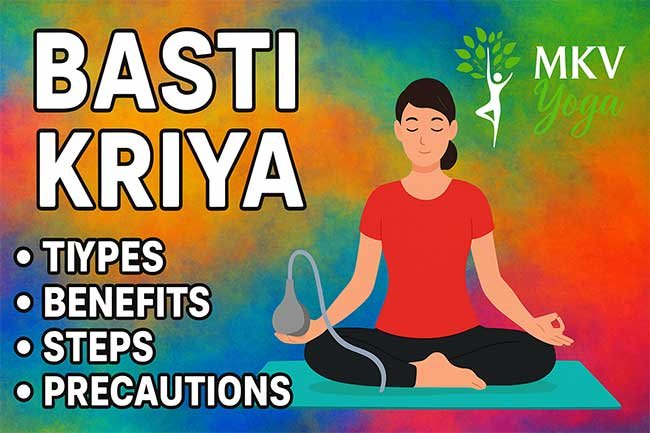In Yoga, Shatkarma (six cleansing techniques) play a vital role in purifying the body and preparing it for higher practices of pranayama and meditation. Basti Kriya, also known as Yogic Enema, is one of these techniques. It is designed to cleanse the colon, balance the digestive system, and remove accumulated toxins.
This kriya is not just about physical cleansing but also about maintaining inner purity, balance, and energy flow in the body.
Table of Contents
Types of Basti Kriya
There are mainly two types of Basti Kriya as described in traditional yogic texts:
1. Jala Basti (Water Enema Cleansing)
-
In this method, lukewarm water is introduced into the colon through yogic techniques or using a simple pipe.
-
It cleanses the large intestine, removes toxins, and improves digestion.
2. Sthala Basti (Dry Basti / Without Water)
-
Practiced without using water.
-
Involves the contraction and relaxation of abdominal and pelvic muscles to expel impurities naturally.
-
Considered more advanced and requires strong control over Uddiyana Bandha and Nauli Kriya.
Steps to Practice Basti Kriya
Note: Always learn Basti Kriya under the guidance of a qualified yoga teacher.
For Jala Basti:
-
Fill a small enema pot or container with lukewarm water.
-
Sit in Utkatasana or squat posture.
-
Insert the tube gently into the rectum.
-
Allow water to enter slowly.
-
Perform gentle Nauli Kriya (abdominal churning) to circulate water.
-
After 5–10 minutes, release the water naturally by sitting in the toilet.
For Sthala Basti:
-
Sit in Paschimottanasana or squat position.
-
Perform Uddiyana Bandha and abdominal contractions.
-
By creating a vacuum pressure, air is drawn inside and helps in colon cleansing.
-
Expel the air and impurities through controlled muscular movements.
Benefits of Basti Kriya
-
Detoxifies the large intestine and removes impurities.
-
Improves digestion and absorption of nutrients.
-
Relieves constipation, gas, and bloating.
-
Enhances metabolism and helps in weight management.
-
Balances the Apana Vayu (downward energy) in the body.
-
Prepares the body for advanced yogic practices and meditation.
-
Promotes mental clarity and inner peace.
Who Should Avoid Basti Kriya
-
Pregnant women.
-
People with rectal bleeding, piles, or fissures.
-
Those suffering from chronic diarrhea, ulcerative colitis, or Crohn’s disease.
-
Individuals with a hernia or who have undergone abdominal surgery.
-
Should not be practiced excessively – once a week or as prescribed.
FAQs on Basti Kriya
Q1. What is Basti Kriya in Yoga?
Basti Kriya is a yogic cleansing practice for the large intestine, utilizing either water (Jala Basti) or air (Sthala Basti).
Q2. Is Basti Kriya safe for everyone?
No, it should be avoided by people with digestive disorders, piles, or during pregnancy. Always consult a yoga expert.
Q3. How often should Basti Kriya be practiced?
Generally, once a fortnight or as recommended by a yoga teacher is sufficient for detoxification.
Q4. What are the main benefits of Basti Kriya?
It cleanses the colon, removes toxins, improves digestion, and enhances physical & mental energy.
Conclusion
Basti Kriya is an ancient yogic purification technique that deeply cleanses the digestive system and prepares the body for higher practices. When practiced correctly, it brings lightness, health, and clarity to both body and mind. However, it should always be learned from a trained yoga teacher and performed mindfully.
You may also like to read –
What Is Hatha Yoga, What Are Its Constituents & What Is Purpose Of Hatha Yoga

